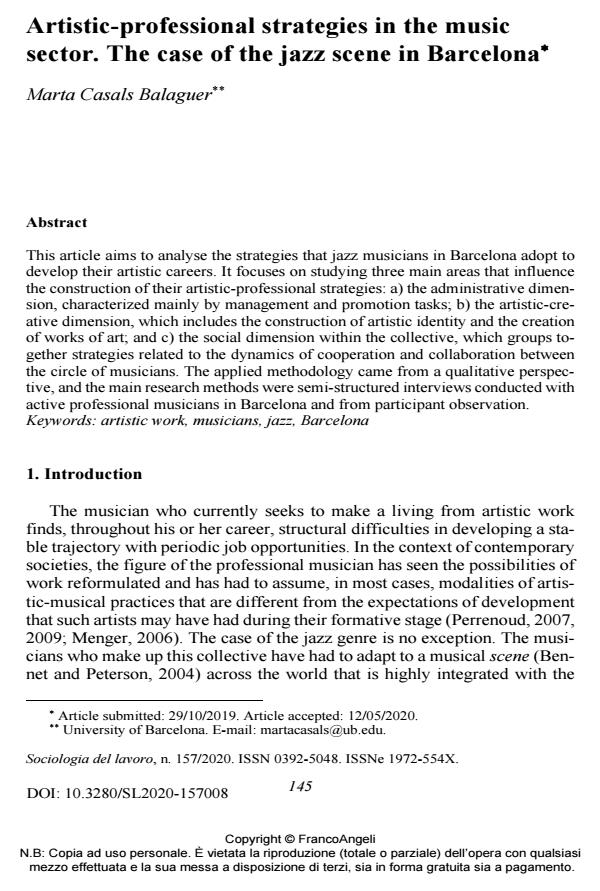Artistic-professional strategies in the music sector. The case of the jazz scene in Barcelona
Titolo Rivista SOCIOLOGIA DEL LAVORO
Autori/Curatori Marta Casals Balaguer
Anno di pubblicazione 2020 Fascicolo 2020/157
Lingua Inglese Numero pagine 19 P. 145-163 Dimensione file 267 KB
DOI 10.3280/SL2020-157008
Il DOI è il codice a barre della proprietà intellettuale: per saperne di più
clicca qui
Qui sotto puoi vedere in anteprima la prima pagina di questo articolo.
Se questo articolo ti interessa, lo puoi acquistare (e scaricare in formato pdf) seguendo le facili indicazioni per acquistare il download credit. Acquista Download Credits per scaricare questo Articolo in formato PDF

FrancoAngeli è membro della Publishers International Linking Association, Inc (PILA)associazione indipendente e non profit per facilitare (attraverso i servizi tecnologici implementati da CrossRef.org) l’accesso degli studiosi ai contenuti digitali nelle pubblicazioni professionali e scientifiche
This article aims to analyse the strategies that jazz musicians in Barcelona adopt to develop their artistic careers. It focuses on studying three main areas that influ-ence the construction of their artistic-professional strategies: a) the administrative dimension, characterized mainly by management and promotion tasks; b) the artistic-creative dimension, which includes the construction of artistic identity and the creation of works of art; and c) the social dimension within the collective, which groups together strategies related to the dynamics of cooperation and col-laboration between the circle of musicians. The applied methodology came from a qualitative perspective, and the main research methods were semi-structured inter-views conducted with active professional musicians in Barcelona and from partic-ipant observation.
L’articolo si propone di analizzare le strategie che i musicisti jazz residenti a Barcellona adottano per sviluppare la loro carriera artistica. Si concentra sullo studio di tre aree principali che influenzano la costruzione delle loro strategie artistico-professionali: a) la dimensione amministrativa, caratterizzata principalmente da compiti di gestione e promozione; b) la dimensione artistico-creativa, che comprende la costruzione dell’identità artistica e la creazione di opere d’arte; e c) la dimensione sociale all’interno di una dimensione collettiva, che raggruppa le strategie legate alle dinamiche di cooperazione e collaborazione tra la cerchia dei musicisti. La metodologia applicata proviene da un approccio qualitativo e i principali metodi di ricerca sono stati interviste semi-strutturate condotte con musicisti professionisti attivi a Barcellona e dall’osservazione partecipante.
Parole chiave:Lavoro artistico, musicisti, jazz, Barcellona
- Music as professional practice: work profiles of jazz and popular music artists in Barcelona Marta Casals-Balaguer, in Popular Music /2025 pp.1
DOI: 10.1017/S0261143025101116 - El oficio de músico: profesionalización y trabajo artístico en la escena del jazz y la música moderna en Barcelona Marta Casals-Balaguer, in Política y Sociedad /2025 pp.e101540
DOI: 10.5209/poso.101540
Marta Casals Balaguer, Artistic-professional strategies in the music sector. The case of the jazz scene in Barcelona in "SOCIOLOGIA DEL LAVORO " 157/2020, pp 145-163, DOI: 10.3280/SL2020-157008